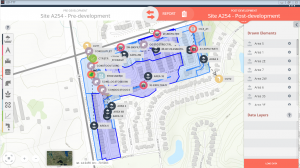Difference between revisions of "Engineering hub"
Jenny Hill (talk | contribs) m |
Jenny Hill (talk | contribs) m |
||
| Line 9: | Line 9: | ||
*[[Natural drainage]] | *[[Natural drainage]] | ||
==Selection of suite of LIDs: the Treatment Train Tool== | ==Selection of suite of LIDs: the Treatment Train Tool== | ||
Revision as of 20:17, 18 March 2018
Low Impact Development's most powerful concepts are in the drainage planning of the entire site, at any scale.
- Reject dated ideas of concentrating all of the stormwater together in one corner.
- Argue against levelling every site into a generic, difficult to drain flatness.
When water is permitted to flow in a greater number of directions, each structural practice or BMP becomes much more efficient and cost effective. Ideas for contemporary site planning strategies can be found in:
Selection of suite of LIDs: the Treatment Train Tool[edit]
In order to assess if the selected suite of BMPs effectively meet the design criteria, use either computer models or simple spreadsheet models. Base Mmdel selection on the size and type of development. A wide range of simple to complex computer models such as Visual OTTHYMO, SWMM, SWMMHYNO, HSP-F and QUALHYMO are available. See Modeling.
STEP have developed the Low Impact Development Treatment Train Tool to help developers, consultants, municipalities and landowners understand and implement sustainable stormwater management planning and design practices.
Mathematical notation used throughout the site.
